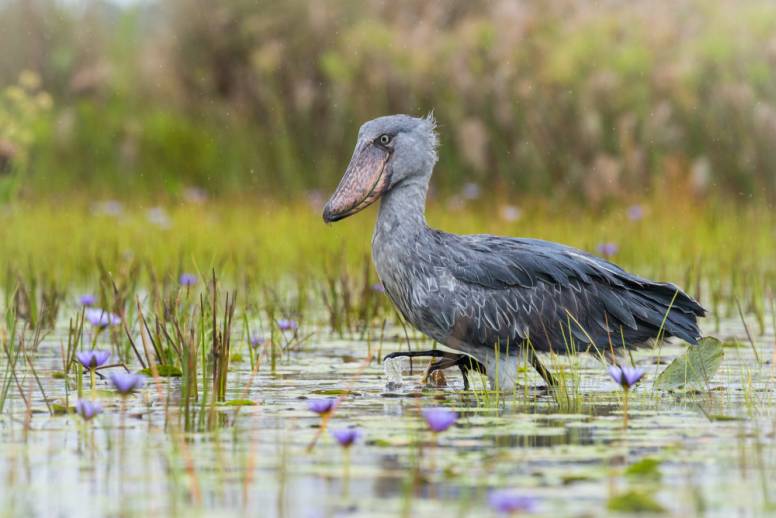


As in the pelicans, the upper mandible is strongly keeled, ending in a sharp nail. The exposed culmen (or the measurement along the top of the upper mandible) is 18.8 to 24 cm (7.4 to 9.4 in), the third longest bill among extant birds after pelicans and large storks, and can outrival the pelicans in bill circumference, especially if the bill is considered as the hard, bony keratin portion. The signature feature of the species is its huge, bulbous bill, which is straw-coloured with erratic greyish markings. A male will weigh on average around 5.6 kg (12 lb) and is larger than a typical female of 4.9 kg (11 lb). Weight has reportedly ranged from 4 to 7 kg (8.8 to 15.4 lb).

Length from tail to beak can range from 100 to 140 cm (39 to 55 in) and wingspan is 230 to 260 cm (7 ft 7 in to 8 ft 6 in). The shoebill is a tall bird, with a typical height range of 110 to 140 cm (43 to 55 in) and some specimens reaching as much as 152 cm (60 in). The shoebill's conspicuous bill is its most well-known feature All that is known of Eremopezus is that it was a very large, probably flightless bird with a flexible foot, allowing it to handle either vegetation or prey. It has been suggested that the enigmatic African fossil bird Eremopezus was a relative too, but the evidence for that is unconfirmed. So far, two fossilized relatives of the shoebill have been described: Goliathia from the early Oligocene of Egypt and Paludavis from the Early Miocene of the same country. A 2008 DNA study reinforces their membership of the Pelecaniformes. In 2003, the shoebill was again suggested as closer to the pelicans (based on anatomical comparisons) or the herons (based on biochemical evidence). Microscopic analysis of eggshell structure by Konstantin Mikhailov in 1995 found that the eggshells of shoebills closely resembled those of other Pelecaniformes in having a covering of thick microglobular material over the crystalline shells. Based on osteological evidence, the suggestion of a pelecaniform affinity was made in 1957 by Patricia Cottam. Traditionally considered as allied with the storks ( Ciconiiformes), it was retained there in the Sibley-Ahlquist taxonomy which lumped a massive number of unrelated taxa into their "Ciconiiformes".

The genus name comes from the Latin words balaena "whale", and caput "head", abbreviated to -ceps in compound words. John Gould described it in 1850, giving it the name Balaeniceps rex. The shoebill was known to ancient Egyptians but was not classified until the 19th century, after skins and eventually live specimens were brought to Europe.


 0 kommentar(er)
0 kommentar(er)
